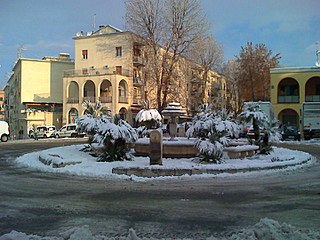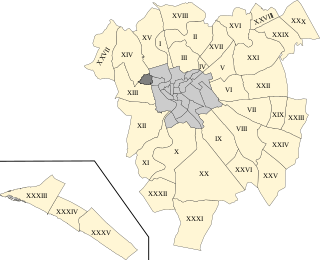
The Province of Rieti is a province in the Lazio region of Italy. Its capital is the city of Rieti. Established in 1927, it has an area of 2,750.52 square kilometres (1,061.98 sq mi) with a total population of 157,887 people as of 2017. There are 73 comuni in the province.

The city of Rome, Italy is divided into first-level administrative subdivisions.

Monte Soratte is a mountain ridge in the Metropolitan City of Rome, central Italy. It is a narrow, isolated limestone ridge with a length of 5.5 km (3.4 mi) and six peaks. Located some 10 km (6.2 mi) south east of Civita Castellana and c. 45 km (28 mi) north of Rome, it is the sole notable ridge in the Tiber Valley. The nearest settlement is the village of Sant'Oreste. Saint Orestes or Edistus, after whom the settlement is named, is said to have been martyred near Monte Soratte.

Prati is the 22nd rione of Rome, identified by the initials R. XXII. It belongs to the Municipio I since 2013, while previously, along with Borgo and quartieri Trionfale and Della Vittoria, it was part of the Municipio XVII.

The Astronomical Observatory of Rome is one of twelve Astronomical Observatories in Italy. The main site of the Observatory is Monte Porzio Catone. Part of the Istituto Nazionale di Astrofisica since 2002.

Primavalle is the 27th quartiere of Rome, identified by the initials Q. XXVII. It is part of the Municipio XIV.

The Municipio XIX was an administrative subdivision of the city of Rome. Following the administrative reform of 11 March 2013, it was suppressed and merged into the new, and coextensive, Municipio XIV. Its territory is situated to the north-west part of the municipality of Rome.
Balduina is an urban area that belongs to the Municipio XIX of the comune of Rome, and to the fourteenth borough of the city,. Situated at 139 metres above sea level on the southern side of Monte Mario, Balduina is the highest part of Rome. The population is 42,000.

Municipio I is an administrative subdivision of the municipality of Rome, encompassing the centre of the city.

The FL3 is a commuter rail route. It forms part of the network of the Lazio regional railways, which is operated by Trenitalia, and converges on the city of Rome, Italy.

The following outline is provided as an overview of and topical guide to Rome:

The Quarters of Rome are the areas in and around the Italian city of Rome which became urbanised after the foundation of the last city-centre rione, Prati.

The Riserva Naturale di Monte Salviano or Riserva naturale guidata Monte Salviano is a nature reserve in Abruzzo, Italy, established in 1999. It lies in the territory of the comune (municipality) of Avezzano, in the Province of L'Aquila. The reserve is named after Monte Salviano, a massif that extends northwest to southwest dividing the Fucine basin from the Palentine Plains, in the Marsica sub-region.

Madonna del Rosario is a church of Rome (Italy) in the Quarter Della Vittoria, rising in Via Trionfale, Monte Mario.
Forte Monte Mario is one of the 15 forts of Rome, built between 1877 and 1891.
It is located in Rome (Italy), in the Quarter Q. XV Della Vittoria, within the Municipio I.
Forte Braschi is one of the 15 forts of Rome, built in the period between 1877 and 1891 to constitute the "entrenched field of Rome".
It is located in the Quarter Q. XIV Trionfale, within the Municipio XIV.

The Suburbi di Roma are the third level of toponomastic subdivision of the Municipality of Rome (Italy).

Aurelio is the 13th quartiere of Rome (Italy), identified by the initials Q. XIII. It belongs to the Municipio XIII and Municipio XIV.

Trionfale[trioɱˈfaːle] is the 14th quartiere of Rome (Italy), identified by the initials Q. XIV. The toponym also indicates the urban zone 19E of Municipio XIV.


















